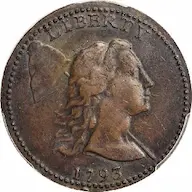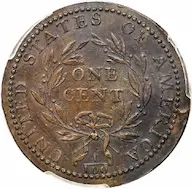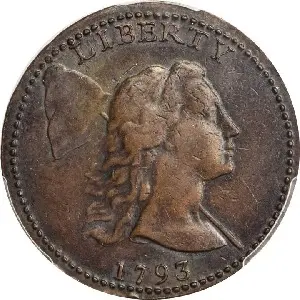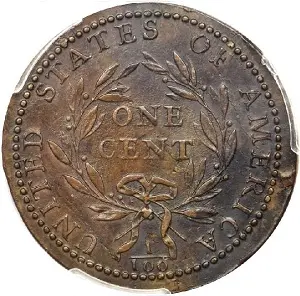1793 Liberty Cap Cent
The first coins issued for circulation by the United States were the half cents and one cents of 1793. There were three design types for the one cent denomination during the initial year of production.
The first cent type, the Flowing Hair Chain Reverse, was not well received by the public. It depicted Miss Liberty as if she was having a frightful, bad hair day. The reverse featured a chain intended to symbolize national unity, but was viewed by some as a reference to bondage and slavery, a bad omen for liberty.(1)
Complaints led to the replacement of the chain with a wreath within a matter of weeks. The Flowing Hair Wreath Reverse was an improvement, but critics continued to whine about the maniacal Liberty, so the second 1793 one cent type was replaced by a third type, this one bearing the Liberty Cap motif.
The Liberty Cap design is generally credited to Joseph Wright and features Miss Liberty with a conical shaped cap and pole over her left shoulder.(2) The “liberty cap”, originally called a Phrygian cap, dates back to ancient times when liberated slaves wore this headgear to signify their emancipation. Over the centuries, the liberty cap came to symbolize the concept of freedom and the pursuit of liberty.(3)
The freedom cap was a popular symbol during the Revolutionary War era, appearing on numerous buttons worn by patriots and soldiers.(4) American colonists foisted the liberty cap upon a pole to rally for the cause of independence.(5) It was this imagery that provided inspiration for the Liberty Cap cent and half cent.
The Liberty Cap cent was made from 1793 to 1796. Examples are easily obtainable with the sole exception of the 1793 issue. Only 11,056 pieces were struck, of which about 450 survive to this day.(6)
For such a small mintage, there are a surprising number of die varieties. Four obverse dies and two reverse dies combined to generate six die marriages. The S-13 is the most seen variety, with the NC-6 being the rarest.(7) Selling prices can vary considerably according to variety.(8)
Fascinating Fact: The 11,056 mintage of 1793 Liberty Cap cents were delivered to the Mint’s treasurer for public distribution on September 18, 1793. Joseph Wright, the engraver generally acclaimed as the designer of the coin, passed away less than a week earlier of the yellow fever plague that shut down Philadelphia occasionally around the turn of the 18th century.(9)
The value trendlines of the 1793 Liberty Cap cent has been very strong for decades, reflective of its rarity, historical significance, and sustained collector interest. However, prices have taken a breather since their last cyclical highs from the early 2010’s, but the overall trends remain robust.
Important Note: As is true for most early U.S. large cents, the typical 1793 Liberty Cap cent usually has problems: corrosion, surface damage, cleaning, heavy marks, or poor strike. Shop around for a problem-free example of good eye appeal.(10) Be prepared to pay a premium for such a piece, but it’s an investment likely to pay off.
| Estimated survivors in all grades: 450 ?
The survivor estimate from PCGS represents an average of one or more experts' opinions as to how many examples survive of a particular coin in all grades. Survival estimates include coins that are raw, certified by PCGS, and certified by other grading services. Learn more at PCGS. |
| PCGS Rarity Scale: 6.1 ?
The 'PCGS CoinFacts Rarity Scale' assesses the relative rarity of all U.S. coins, based on estimated surviving examples. The scale runs from 1.0 to 10.0. The higher the number, the rarer the coin.
Learn more at PCGS. |
| Search for the 1793 Liberty Cap Cent on eBay** |
Preview of eBay selection (if no 1793 Lib Cap cents in Preview, click the Search link above):
 |
 |
| Trendline Avg = 20.57 | BETTER |
 |
 |
| Trendline Avg = 20.57 | BETTER |
Historic Value Trend Charts:
| Last updated 11-9-25 | Return to Key Date Coin List | |
| Compare to Common Date Coin of Same Type | ||
|
|
||
| Download Charts to Your Computer | ||
Sources
1. PCGS. Flowing Hair Large Cent.
2. Bowers, Q. David. The History of United States Coinage. Los Angeles, CA: Bowers and Ruddy Galleries, Inc., 1979.
3. The Phrygian Cap.
4. PCGS. 1793 1C Liberty Cap, BN (Regular Strike).
5. Landrigan, Leslie. "Six Places That Raised a Liberty Pole". New England Historical Society. 2022.
6. PCGS. 1793 1C Liberty Cap, BN (Regular Strike).
7. Heritage Auctions. 1793 1C Liberty Cap. Jan 2012 Auction.
8. Yeoman, R.S. and Garrett, Jeff, et al. A Guide Book of United States Coins, 75th ed. Pelham, AL: Whitman Publishing, 2021.
9. Taxay, Don. The U.S. Mint and Coinage. New York, NY: Sanford J. Durst Numismatic Publications, 1966.
10. PCGS. 1793 1C Liberty Cap, BN (Regular Strike).
**Many very fine coin dealers sell on eBay. At any point in time, there may be over one million search results for United States coins. This includes quite a few of the recommendations on our Key Date Coin List.
If you’re thinking about purchasing a rare coin, eBay is certainly worth a look. For your convenience, the links from this site to eBay are coded to bring up only coins certified by PCGS and NGC.
As is always, always the case, never buy a valuable coin from a seller whose trustworthiness cannot be verified. Learn more about this at our chapter Best Places to Buy Coins, which also has a section on doing business on eBay.
In the interest of full disclosure, Rare Coins 101 receives a small commission anytime someone connects to eBay from this site and purchases something.
Coin images by Stack's Bowers Galleries.


